Chocolate

Spanish colonizers introduced cacao crops in Costa Rica during the 17th century, reshaping the country’s economy. Cacao seeds seeds grow into trees whose beans are harvested and then turned into chocolate. This bitter bean is turned into a sweet treat through a process that first involves roasting the beans and crushing them into a paste. Next, the paste is tempered, a repetitive process of heating and cooling, until chocolate is formed. Higher quality chocolates can take up to a week to produce. Milk and sugar can be added to the chocolate to form different varieties. Many farms on the Osa Peninsula, such as a family run farm called Rancho Raices, produce and sell their own chocolate. Additionally, farms give tours as a source of income from tourists.
Palm Oil

Palm oil comes from the fruit of palm trees Native to Africa. Two to three years after being planted, palm fruits are harvested and mechanically pressed to extract oil. The pulp contains most of the oil, however the kernels are utilized for further extraction. The oil undergoes a refining process which may include degumming, bleaching, and deodorizing. Finally, oil is separated by its liquid and solid components. Palm oil plantations, such as Palmas del Pacífico and Palma Tica, exist all over Costa Rica. Palm oil is globally traded due to its versatility and high demand.
https://www.foodunfolded.com/article/palm-oil-how-its-made
https://growjungles.com/costa-ricas-african-palm-oil-dilemma-unraveling-the-ecological-catastrophe/
Bananas
Costa Rica is one of the top producers of bananas. Bananas grow from a bulb and take 9-12 months before they are ready to be harvested. The fruits are harvested while they are still green before being inspected and sorted. High quality bananas are selected to be exported. Humidity, ventilation, and temperature conditions are monitored carefully during the transportation process to maintain quality. Bananas are then ripened using ethylene gas before they are ready to be sold in stores. Bananas are available year round. Independent growers sell their bananas to companies such as Del Monte, with the US being one of Costa Rica’s top consumers.
https://freshdelmonte.com/products/ https://www.bananalink.org.uk/all-about-bananas/#:~:text=Bananas%20do%20not%20grow%20from,are%20available%20all%20year%20round.
Coffee

Coffee has been a part of Costa Rica’s agriculture since the late 1700s. Coffee beans are harvested from cherry-like fruits about three to four years after being planted. Beans are next processed, sun dried, and milled. Beans are sorted by size and inspected to ensure that the beans being used are high quality. Finally, the beans are ready to be exported and sold both locally and to other countries. A few Costa Rican coffee plantations include: Poás Volcano, Tres Rios, Naranjo, Alajuela and Tarrazú. Income is also generated through coffee farm tours.
https://www.ncausa.org/about-coffee/10-steps-from-seed-to-cup
https://www.govisitcostarica.com/travelInfo/day-trips/coffee-plantaions.asp
Vanilla

Vanilla comes from an orchid which grows on a vine. After about three years, the flower blooms for one day and must be hand pollinated. Next the beans must be curated in a process of blanching and immersion in hot water, allowing for the development of the vanilla flavor. The beans are then fermented, laid in the sun, and cured. The labor process takes at least a year, sometimes longer. Dried beans are ready for exportation globally. The National University, Osa Conservation, and University of Costa Rica have been working to establish vanilla farms for more economic opportunities, starting trial plots on the Osa Verde farm.